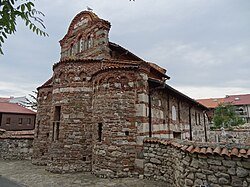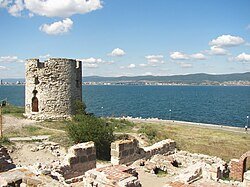Nessebar (Bulgarian: Несебър Nesebǎr) is a city in Bulgaria, in Burgas Province and the seat of Nessebar Municipality, located on a small peninsula on the Black Sea coast, population 14,157. The city has been an architectural and archaeological reserve since 1956, and since 1983 the cultural monuments in the city have been included on the UNESCO World Heritage List.

- Windmill on the causeway leading to the old town. In Nessebar, on the causeway connecting the Old Town with the new part of the city, there is a characteristic windmill. It is a wooden structure that is one of the symbols of Nessebar and is a popular place for tourists to take photos. The windmill is not open to visitors inside, but the causeway itself is a place to walk and admire the views of the city and the port.

- Ruins of fortifications. There are numerous ruins of fortifications in Nessebar, which are remnants of different historical periods of the city. The oldest walls date back to Thracian times (8th century BC), and were later expanded by the Greeks and Byzantines. Fragments of the walls have been preserved, including those that can be seen when entering the city, as well as on the northern side of the peninsula.

- The Church of St. Stephen (also known as the New Bishopric) is a historic Orthodox church in the Bulgarian city of Nessebar, one of the few surviving Orthodox churches out of over 40 that once existed in the city. The church was built in the 11th–13th centuries as a three-nave basilica, with the central nave being higher than the side naves and having oval-shaped eastern and western walls (apse and narthex). The building was built of both stone and brick. Many elements, such as cornices, column capitals and reliefs, from destroyed, earlier buildings were reused as part of the recovery process. The façade is decorated with glazed ceramic elements in various colours and majolica ceramics.

- Church of the Holy Archangels Michael and Gabriel – Orthodox church in Nessebar. It was built in the 13th century as a single-nave church with a narthex with two entrances: from the north and south. The length of the building is 14 m, with a width 5.2 m. Preserved in the form of a ruin, without a roof and vaults.

- Church of the Most Holy Mother of God Eleusa in Nessebar – a ruined Orthodox church in the Bulgarian town of Nessebar, dating from the 5th or 6th century, built on a basilica plan with a narthex and three apses measuring 28 meters by 18 meters. Significantly rebuilt in the 14th century as part of a monastery complex.

- Interesting facts. After Bulgaria’s liberation from Ottoman rule in 1879, Nesebar became part of the autonomous Ottoman province of Eastern Rumelia in the department of Burgaz until its unification with the Principality of Bulgaria in 1885. At the end of the 19th century, Nesebar was a small town of Greek fishermen and winemakers. Around 1900, it had about 1,900 inhabitants, 89% of whom were Greeks, but remained relatively unpopulated.From the beginning of the 20th century, it began to develop as an important Bulgarian seaside resort. After 1925, a new part of the town was built, and the historic Old Town was restored.

